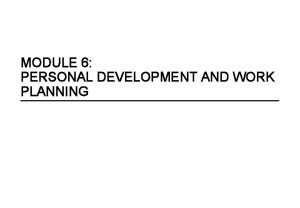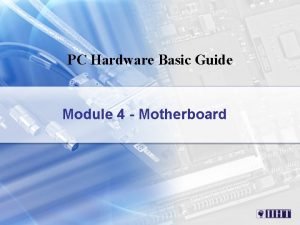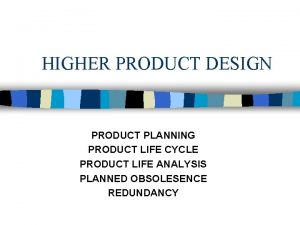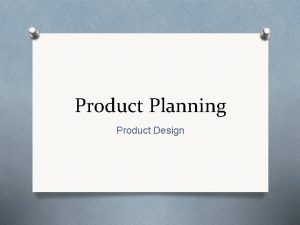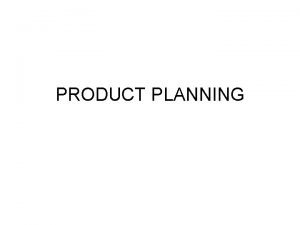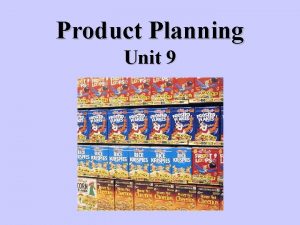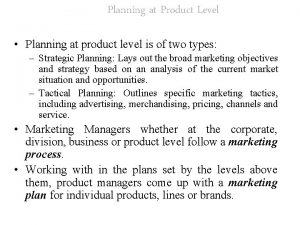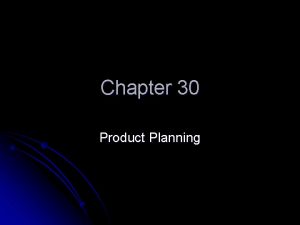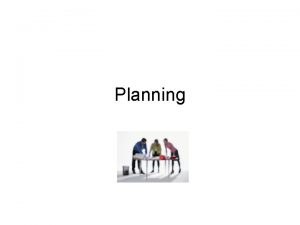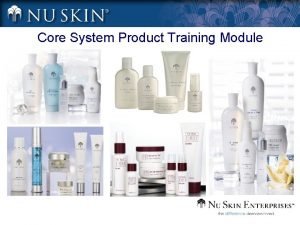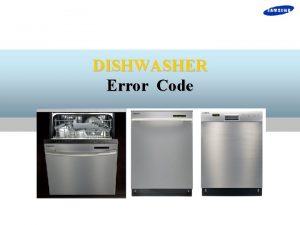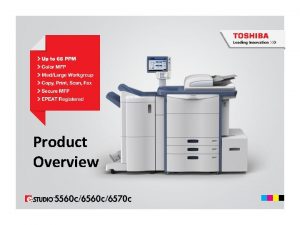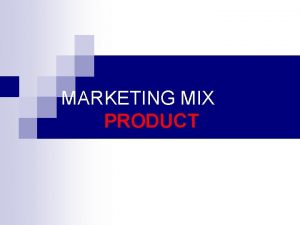The Product Planning System Module II The Product






















































- Slides: 54

The Product Planning System

Module II: The Product Planning System 1. The Traditional Approaches to Product Planning 2. A Matrix Approach to Product Planning 3. Product Evaluation Matrix in a Nutshell 4. A Model to Add Clarity and System to the Judgments Involved in Product Planning 5. PLC as an aid to Product Planning 6. Operational zing the PLC 7. PLC as a Tool to Plan Market Share Strategies

The Traditional Approaches to Product Planning: product planning deals with : • Defining new products and gathering Market requirements, • Life cycle of the product considerations, • Product Portfolio management , • Product differentiation and • Building product roadmaps, particularly Technology roadmaps

The Traditional Approaches to Product Planning: Product Planning Creation of Value Delivery Of Value Product Planning is the ongoing process of identifying and articulating that define a product’s feature set.

(MRD Market Requirements Document)

Product Plan A product plan describes ü The market opportunity, ü Profiles the target customers, ü Specifies pricing, ü Identifies the financial goals, ü indicates the key priorities for development & enhancement, and ü Provides a roadmap for delivery of the Product to the customer

Goal Of A Product Plan: The essential goal of a product plan should be to ensure that a product is built that delivers some business value to a specific set of customers in order to meet certain financial goals based upon a defined corporate strategy. Successive plans should increase that product’s effectiveness in doing so.

Steps To Product Plan: 1. Let’s assume that the product management department is already managing several products that are currently serving customers. 2. After getting feedback from customers, 3. Speaking with the sales teams, 4. Obtaining a list of the top technical support issues, 5. Surveying competitor positions and features, and 6. Receiving new ideas from development, 7. The product management team has generated a list of possibly hundreds of potential product 8. Enhancements across the product line as well as some new product ideas. 9. Project prioritization typically takes place next due to limited development resources.


Internet Learning Creating a Strategic Product Plan — Pragmatic Marketing, world's most popular product management training. mht

The Traditional Approaches to Product Planning: Corporate Strategic planning Group Or Sector planning SBU Planning Annual Marketing (Business) Plan Hierarchy Of Planning

Project Assignment: 1. Take any three products being sold in the market, explain their roles, and also categorize them according to their Level. 2. Take any products from categories Like FMCG, consumer durables, automobile, garments, and explain how the features of these products have been decided and Fit in a product portfolio Matrix based on your selection.

A Matrix Approach to Product Planning

A Matrix Approach to Product Planning

Matrix Approach • Development of a strategic plan for the Existing line is the most critical element of a company’s product planning activity. • In designing, such plans Management needs accurate information on the current and anticipated performance of the products. The information should encompass Both 1. Consumer evaluation of the company's products, particularly their strengths weakness viz a viz competition (I; e Product Positioning by market Segment information. )

2) “objective” information on actual and anticipated product performance on relevant criteria such as sales, profits and market share. Other approaches Such as BCG, PIMS ETC. . (Profit impact of market Strategy by MSI) do not , however, provide a comprehensive approach for product planning based on all three measures- sales, market share, and profitability Therefore matrix approach is adapted to product planning

Product Evaluation Matrix in a Nutshell

Product Evaluation Matrix in a Nutshell In Product evaluation matrix Has: 1. Two definitional phases followed by 2. Five Analytical stages.

Definitional Phases : Phase A- define the relevant universe in terms of the relevant strategic product/ market area. The Product of concern and the strategic market. This requires determination of: a) The product of concern – The Product definitions should be clear and unambiguous, and in all cases they should include the relevant sud- categories of the product class at both the Company and the industry levels.

Definitional Phases : contd. . b) The strategic market • Specific Market • Domestic market • International market etc Further segmentation can be undertaken I; e commercial market, Private market (OEM) Industrial market, This will give a sharper focus and meaning to the PLC analysis Ex- Sub. compact, intermediate, standard, sport and luxury automobiles

Definitional Phases : contd. . Phase B- Establish the relevant Measurement instruments in terms of units (Rs sales or unit sales, necessary adjustments (e. g sales per capital) and time (e. g quarterly or annually)

The Analytical phases 1. Phase A: Determine and examine the current and the past trends in A) product sales, B) market share, and C) profit position in each relevant strategic product/ market. Specifically, if it necessary to establish the following: 2. Sales position; Given product in a specific market. (Based On the PLC Structure ) 3. Market Share position: Market share in Strategic market. By determining market Share categories and the assignment criterion.

• If the market share <10%assign to the marginal category • If, market share is Marginal, 10 -20%assign to the average Category • If market Share is >25%assign to the Leading category Note: The market share figures that establish the three Categories may , of course, vary from one strategic product/ market area to another

3. Profit position : Phase B: After the unconditional/ unidimensional analysis suggested in phase A completed it is nessary to combine the Four uni-dimensional Scales I; e • Industry Sales, • company sales, • Market share. • Profit - into a comprehensive scheme. The integration of the four dimensions into a single analytical framework constitutes The product Evaluation Matrix.

Position all the products in the matrix, based on hard data on sales, market share and profitability. A more advance approach can be adapted variable where Each of the four dimensions is presented as a continuous variable and not as a categorical one that is based on arbitrary decision rule or adapt a simple positioning of the product in the matrix

Phase C: Although the product evaluation matrix provides a useful tool for controlling the performance of the firm’s product line and answering the question “where are we”

Assign product to one of the following category A) Sales: Sl 1 2 3 Stage Industry Decline Stable Growth Sales Trend: Sales Company Sales Industry Time Company

Assign product to one of the following category B) Market share: Market share Industry Time Sl 1 2 3 Market Position Marginal MP Average MP Leading MP Industry

Assign product to one of the following category C) Profitability: Sl 1 2 3 Profit Position Below target Above target Profitability: Time Industry

Different Types of Matrix • Product SWOT Matrix • The strategic position and action evaluation (SPACE) Matrix • BCG Matrix • IE matrix- the internal external matrix • The grand strategy matrix • The quantitative strategic planning matrix (QSPM)

Strategic Position and Action Evaluation (SPACE • Strategic Position and Action Evaluation (SPACE) Matrix has been materialized as a dominant instrument in formulating alternative strategies. Like Grand Strategy Matrix this matrix is also based on four important elements called four quadrants of SPACE Matrix. • First two elements called internal dimensions which are Financial Strength (FS) and Competitive Advantage (CA) and • other two are called external dimensions namely Environmental Stability (ES) and Industry Strength (IS). • Undoubtedly these four rudiments are conceivably the most imperative determinants of an organization’s Products by and large strategic position. • The four quadrants framework of SPACE Matrix represents the suitability or appropriateness of the strategies to be selected by a company such as aggressive, conservative, defensive, or competitive

Product falling in four quadrants should adopt the strategies as follows: • Quadrant I : Financial Stability and Industry Strength Aggressive • Quadrant II : Financial Stability and Competitive Advantage Conservative • Quadrant III : Competitive Advantage and Environmental Stability Defensive • Quadrant IV : Industry Strength and Environmental Stability Competitive


• http: //www. slideshare. net/reddragonstrikes /hul-company-ppt-presentation

• Devices that integrate multiple functions together are popular in consumer electronic markets. We describe these multifunction devices as fusion products as they fuse together products that traditionally stand alone in the marketplace. In this article, we investigate the manufacturer's fusion product planning decision, adopting a market offering perspective that allows us to address the design and product portfolio decisions simultaneously. The general approach adopted is to develop and analyze a profit-maximizing model for a single firm that integrates product substitution effects in identifying an optimal market offering. In the general model, we demonstrate that the product design and portfolio decisions are analytically difficult to characterize because the number of possible portfolios can be extremely large. The managerial insight from a stylized all-in-one model and numerical analysis is that the manufacturer should, in most cases, select only a subset of fusion and single-function products to satisfy the market's multidimension needs.

• This may explain why the function compositions available in certain product markets are limited. In particular, one of the key factors driving the product portfolio decision is the margin associated with the fusion products. If a single all-in-one fusion product has relatively high margins, then this product likely dominates the product portfolio. Also, the congruency of the constituent single-function products is an important factor. When substitution effects are relatively high (i. e. , the product set is more congruent), a portfolio containing a smaller number of products is more likely to be optimal.

• productMatrix. xls

PLC As An Aid To Product Planning

PLC as an aid to Product Planning • As we saw in the Managing External Forces and Marketing Planning and Strategy tutorials, there are many components, both internal and external, that must be considered within the marketing planning process. • In fact, for many marketers creating the Marketing Plan represents one of the most challenging and burdensome tasks they face. Fortunately, • Over the years marketing academics and professionals have put forth theories, models and other tools that aid planning. Possibly the most widely used planning tool within marketing is the Life Cycle (PLC) concept

PLC as an aid to Product Planning contd…. • The basic premise of the PLC is that products go through several stages of “life” with each stage presenting the marketer with different challenges that must be met with different marketing approaches. • By understanding a product’s position in the PLC, the marketer may be able to develop more effective plans.

• There have been several attempts over the years to define the stages that make up the PLC. • Unfortunately, the PLC may be different for different products, different markets and different market conditions (e. g. , economic forces). • Consequently, there is not a one-model-fitsall PLC. • Yet there is enough evidence to suggest that most products experience patterns of activity that divide the evolution of the product into five distinct stages.

PLC: Product Life Cycle • Products do not have Unlimited life spans Cox Peter (1967) had defined the time span of the product life cycle (PLC) as the time from commercial birth to the commercial end of the product.

Factors that Impact PLC Many factors make impact on PLC. Some of the complex factors are: 1. 2. 3. 4. 5. Design Technological changes The cost of repair The availability of spares and replaceable Household affluence (both for Bto. B, Bto. C) 6. 7. 8. 9. 10. 11. Residual resale value Aesthetics Functional quality Fashion Advertising Social pressure

Factors that Impact PLC Traditionally, obsolesces was regarded as the prime cause for products demise. A Lot of researchers have pointed three categories of Product obsolesces which include: 1. Failure of the product. 2. Dissatisfaction 3. Change in Consumer needs

Factors that Impact PLC In contrast , Kosttecki(1998) classified the determinates of durability as : 1. Functional aspect 2. Economic aspect 3. Symbolic aspect (standing with times) 4. Product performance (towards beginning PLC) 5. 6. Financial & Customer related aspects ( at the end of PLC) Cost involved during the creation and up gradation of the product during a PLC Called life cycle costs is an important factor 7. “Net present cash flow” of the PLC relates to the usefulness of the product when compared to the development costs.

Case study: Rexona Deo • productCzse study -rexona deo. doc

• The Stages of the Product Life Cycle: – Development – Introduction/Launch – Growth – Maturity – Saturation – Decline – Withdrawal


Product Life Cycles Saturation Sales Growth Maturity Decline Introduction Development Time

Development & Introduction Development – Occurs before the product is released to the market and is principally a time for honing the product offering and preparing the market for product introduction. Introduction: • As a new product much time will be spent by the organisation to create awareness of its presence amongst its target market. Profits are negative or low because of this reason. • Introduction – Product is released to the market and sales begin though often gradually as the market becomes aware of the product.

Introduction: • This stage is the most risky & expensive stage because substantial finances must be spent not only to develop the product but also in seeking customer acceptance of the offering • As a new product much time will be spent by the organisation to create awareness of its presence amongst its target market. Profits are negative or low because of this reason. • Introduction – Product is released to the market and sales begin though often gradually as the market becomes aware of the product.

Growth: • If consumers clearly feel that this product will benefit them in some way and they accept it, the organisation will see a period of rapid sales growth. • If the product is accepted it may reach a stage of rapid growth in sales and in profits.

Maturity • Rapid sales growth cannot last forever. Sales slow down as the product sales reach peak as it has been accepted by most buyers. • At some point sales of a product may stabilize. For some products the maturity phase can be the longest stage as the product is repeatedly purchased by loyal customers. However, while overall sales may grow year-over-year, percentage sales increases may be small.

Decline. • Sales and profits start to decline, the organisation may try to change their pricing strategy to stimulate growth, however the product will either have to be re-modified, or replaced within the market. • All products eventually see demand decline as customers no longer see value in purchasing the product
 C device module module 1
C device module module 1 Module 6 personal development
Module 6 personal development Strategic planning vs tactical planning
Strategic planning vs tactical planning Goal achievement matrix
Goal achievement matrix Scenario planning workforce planning
Scenario planning workforce planning Proactive planning and reactive planning
Proactive planning and reactive planning Aggregate planning is capacity planning for
Aggregate planning is capacity planning for Short, medium and long term planning in education
Short, medium and long term planning in education Language planning slideshare
Language planning slideshare Aggregate capacity planning
Aggregate capacity planning Examples of aggregate planning
Examples of aggregate planning Hát kết hợp bộ gõ cơ thể
Hát kết hợp bộ gõ cơ thể Bổ thể
Bổ thể Tỉ lệ cơ thể trẻ em
Tỉ lệ cơ thể trẻ em Voi kéo gỗ như thế nào
Voi kéo gỗ như thế nào Chụp phim tư thế worms-breton
Chụp phim tư thế worms-breton Hát lên người ơi
Hát lên người ơi Các môn thể thao bắt đầu bằng tiếng chạy
Các môn thể thao bắt đầu bằng tiếng chạy Thế nào là hệ số cao nhất
Thế nào là hệ số cao nhất Các châu lục và đại dương trên thế giới
Các châu lục và đại dương trên thế giới Công thức tính độ biến thiên đông lượng
Công thức tính độ biến thiên đông lượng Trời xanh đây là của chúng ta thể thơ
Trời xanh đây là của chúng ta thể thơ Mật thư anh em như thể tay chân
Mật thư anh em như thể tay chân Làm thế nào để 102-1=99
Làm thế nào để 102-1=99 Phản ứng thế ankan
Phản ứng thế ankan Các châu lục và đại dương trên thế giới
Các châu lục và đại dương trên thế giới Thể thơ truyền thống
Thể thơ truyền thống Quá trình desamine hóa có thể tạo ra
Quá trình desamine hóa có thể tạo ra Một số thể thơ truyền thống
Một số thể thơ truyền thống Cái miệng xinh xinh thế chỉ nói điều hay thôi
Cái miệng xinh xinh thế chỉ nói điều hay thôi Vẽ hình chiếu vuông góc của vật thể sau
Vẽ hình chiếu vuông góc của vật thể sau Thế nào là sự mỏi cơ
Thế nào là sự mỏi cơ đặc điểm cơ thể của người tối cổ
đặc điểm cơ thể của người tối cổ Thế nào là giọng cùng tên? *
Thế nào là giọng cùng tên? * Vẽ hình chiếu đứng bằng cạnh của vật thể
Vẽ hình chiếu đứng bằng cạnh của vật thể Vẽ hình chiếu vuông góc của vật thể sau
Vẽ hình chiếu vuông góc của vật thể sau Thẻ vin
Thẻ vin đại từ thay thế
đại từ thay thế điện thế nghỉ
điện thế nghỉ Tư thế ngồi viết
Tư thế ngồi viết Diễn thế sinh thái là
Diễn thế sinh thái là Dot
Dot Bảng số nguyên tố lớn hơn 1000
Bảng số nguyên tố lớn hơn 1000 Tư thế ngồi viết
Tư thế ngồi viết Lời thề hippocrates
Lời thề hippocrates Thiếu nhi thế giới liên hoan
Thiếu nhi thế giới liên hoan ưu thế lai là gì
ưu thế lai là gì Hổ đẻ mỗi lứa mấy con
Hổ đẻ mỗi lứa mấy con Khi nào hổ con có thể sống độc lập
Khi nào hổ con có thể sống độc lập Sơ đồ cơ thể người
Sơ đồ cơ thể người Từ ngữ thể hiện lòng nhân hậu
Từ ngữ thể hiện lòng nhân hậu Thế nào là mạng điện lắp đặt kiểu nổi
Thế nào là mạng điện lắp đặt kiểu nổi Module 4 topic 2 components of the space management system
Module 4 topic 2 components of the space management system System administration module
System administration module

